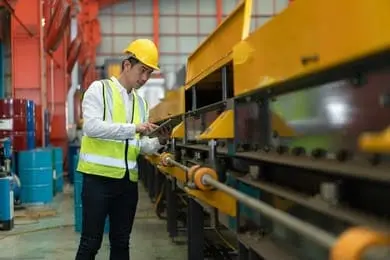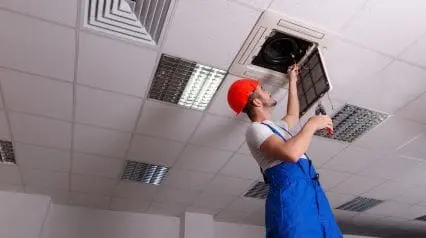What is Preventive Maintenance (PM)?
Preventive maintenance is a type of maintenance strategy that involves regularly checking and servicing equipment or systems to prevent breakdowns and prolong their lifespan. It’s a proactive approach to maintenance that identifies and resolves potential issues before they escalate.
Preventive maintenance aims to minimize unexpected downtime, reduce repair costs, and improve the reliability and safety of equipment or systems. This type of maintenance involves performing routine inspections, cleaning, lubrication, calibration, and replacing worn or damaged parts. Some of the common items or equipment that require it involve electricity, moving parts, solar panels, and the like.
When is it Required?
The frequency of preventive maintenance needed for equipment depends on its type and usage. Setting the schedule according to manufacturer guidelines or industry standards is recommended to ensure a proactive approach instead of a reactive one.
Following a predictive maintenance schedule, which includes condition monitoring, requires accurate documentation of inspections and servicing, along with understanding the lifespan of the equipment. These records will help determine when preventative maintenance is necessary.
Preventive Maintenance vs. Other Forms of Maintenance
Corrective Maintenance
Preventive maintenance is a proactive approach to maintaining equipment or facilities to prevent breakdowns and reduce the likelihood of costly repairs. Conversely, corrective maintenance is reactive and involves fixing equipment or facilities after they have broken down.
Preventive maintenance is generally more cost-effective than corrective maintenance because it helps avoid unexpected downtime and repairs. It also helps extend the life of equipment and facilities, saving money in the long run.
Predictive Maintenance
Preventive maintenance involves regularly scheduled maintenance tasks to prevent breakdowns and keep equipment running smoothly. On the other hand, predictive maintenance uses data and analytics collected from experts, users, and past experiences to predict when maintenance will be needed, allowing maintenance to be scheduled only when
Reactive Maintenance
Preventive maintenance allows for planned downtime and repairs, scheduling them during low production periods to minimize impact. It can also extend the lifespan of equipment and reduce the need for replacement. However, reactive maintenance involves fixing equipment only after it has already broken down. It’s also often called “run-to-failure maintenance.”
Components
Preventive maintenance consists of several critical components designed to keep equipment running smoothly and minimize the need for costly repairs or replacement. These components include:
- Preventing failure by replacing worn components
- Preventing performance degradation by cleaning and restoring components
- Reducing the risk of component or system failures
- Increasing predictability and reliability
- Educating experts on proper procedures and techniques
Types of Preventive Maintenance
The main objective of preventive maintenance is to address problems even before they arise. As such, tasks related to it are done to anticipate, prevent, and prolong the process of equipment breakdown. Different industries operate differently and, as such, use different types of equipment, such as transformers, that require different maintenance methods.
Preventive maintenance comes in different types, depending on the worksite and business requirements, but these types fall under four main categories.
Periodic Maintenance
Also known as time-based maintenance, this is conducted on equipment and other assets at scheduled intervals throughout the year. Preventive maintenance scheduled weekly, monthly, quarterly, or annually fall under this category.
Periodic maintenance guidelines are based on the manufacturer’s recommendation or the mean time between failure (MBTF). The MBTF refers to the average time a machine or equipment operates between stops. Guidelines could also cover failure-finding maintenance (FFM) and risk-based maintenance (RBM) as subcategories.
Performance-Based Maintenance
Also known as meter-based maintenance, this is conducted when a specific meter reading indicates the need for an asset or piece of equipment to be repaired. Meter readings are based on time-based triggers, frequently used maintenance triggers. Common variables this maintenance category measures include hours used, the pressure generated, and the number of parts produced.
Predictive Maintenance
Predictive maintenance is considered the “middle ground” of maintenance; it neither overdoes nor underestimates maintenance procedures and does only what’s necessary to keep equipment in good running condition and prolong its lifespan. This advanced maintenance method uses modern technology like sensors to detect anomalies, automatically generate a work order, and assign it to a technician.
Prescriptive Maintenance
This is the data-driven approach to preventive maintenance that uses cutting-edge technology to transform gathered data into actionable insights. This maintenance method can analyze equipment conditions over time and assess operational risks by leveraging emerging technologies like artificial intelligence (AI) and machine learning. It uses that data to provide specialized recommendations specific to an organization’s scenario and use case.
Industries That Can Benefit from Preventive Maintenance Programs
Organizations with assets to maintain can benefit from preventive maintenance schedules. A few of the industries are listed below.
- Hotels
- Restaurants
- Manufacturing
- Country Clubs
- Facility Management
- Oil/Gas/Utilities
- Governments
- Fleet Management
- Property Management
- Schools
- Information Technology (IT)
Advantages
Enhanced Safety
Regular inspection and maintenance of equipment and machinery can help minimize safety hazards and prevent accidents caused by equipment failure or malfunction. It can contribute to a safer work environment and reduce the risk of injuries or fatalities.
Longer Equipment Life
Regular equipment maintenance can prevent minor issues from turning into significant problems that could cause irreparable damage. It can save money on repairs and replacements and improve efficiency and productivity by ensuring optimal equipment functioning.
Increased Productivity
Research indicates that inadequate maintenance may result in a 20% decrease in a company’s production capacity. Proper upkeep of equipment and machinery can decrease the likelihood of unexpected downtimes, enabling employees to work without hindrance and enhancing productivity and efficiency.
Cost Savings
Preventive maintenance can extend equipment lifespan, delaying replacements or upgrades. Keeping the equipment in good working condition can reduce energy consumption which can help businesses save money on utility bills.
Energy Savings
Preventive maintenance can help identify opportunities for energy upgrades, such as replacing outdated equipment with more energy-efficient models or implementing energy-saving measures like insulation or LED lighting. Proper maintenance of electrical assets can lead to energy efficiency, which can benefit the environment.
Disadvantages
Budget Constraints
Implementing a preventive maintenance program can be costly, especially for small businesses with limited financial resources. The cost of equipment, tools, and materials needed for preventive maintenance can quickly add up, making it difficult for businesses to allocate necessary funds for other areas of the organization.
Additional Resources Required
Preventive maintenance may require more personnel, parts, and time to complete. It can be a high upfront cost for businesses, especially smaller companies with limited budgets. Moreover, preventive maintenance may require additional downtime for equipment, which can impact production schedules and revenue.
Time-Consuming
Regardless of the issues, preventive maintenance involves routine checks, equipment, and system maintenance. Planning and scheduling can also be challenging, requiring coordination between various departments and stakeholders. Failure to address these challenges can result in missed tasks or delays, which could increase the risk of equipment failure or downtime.
Organizational Difficulties
Implementing a preventive maintenance program requires significant planning and coordination across different organizational departments and teams. Keeping track of maintenance schedules, equipment status, and work orders can be challenging, especially if an organization has many assets to manage.
Digitize the way you Work
Empower your team with SafetyCulture to perform checks, train staff, report issues, and automate tasks with our digital platform.
Get Started for FreeFAQs About Preventive Maintenance
Preventive maintenance entails implementing measures to prevent equipment or machinery failures or malfunctions. These responsibilities include regular inspections, cleaning, lubrication, and replacement of parts as needed. It also involves analyzing operating reports and inspecting records to detect defective equipment.
One common reason PM fails is poor planning and scheduling. The lack of proper planning and scheduling of preventive maintenance tasks can result in equipment breakdowns and long downtimes. Another reason why preventive maintenance may fail is due to inadequate training and lack of skills among maintenance personnel.
A preventive maintenance checklist comprises a list of tasks that technicians must accomplish to finalize a preventive maintenance work order. A checklist can help standardize preventive maintenance tasks in your Computerized Maintenance Management System (CMMS) by organizing all necessary steps and information for experienced technicians.
When assessing maintenance, it’s crucial to consider work procedures, equipment history, inventory, and maintenance costs. To gauge maintenance progress and determine results, set performance benchmarks. Key Performance Indicators (KPIs) can aid in monitoring and achieving operational objectives.
The use of technology can also improve preventive maintenance through the utilization of software programs and apps that can track equipment and maintenance schedules and send notifications when maintenance is necessary. This approach can prevent equipment from being overlooked or ignored.




